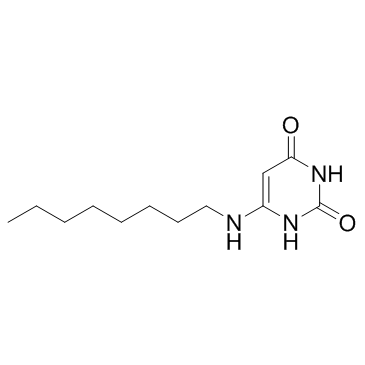6-OAU
Modify Date: 2025-08-25 09:29:38

6-OAU structure
|
Common Name | 6-OAU | ||
|---|---|---|---|---|
| CAS Number | 83797-69-7 | Molecular Weight | 239.314 | |
| Density | 1.1±0.1 g/cm3 | Boiling Point | N/A | |
| Molecular Formula | C12H21N3O2 | Melting Point | N/A | |
| MSDS | N/A | Flash Point | N/A | |
Use of 6-OAU6-OAU(GTPL5846; 6-n-octylaminouracil) is a surrogate agonist of GPR84; activates human GPR84 in the presence of Gqi5 chimera in HEK293 cells with an EC50 of 105 nM in the PI assay.IC50 value: 105 nM [1]Target: GPR84 agonistin vitro: 6-OAU increased [35S]GTPγS incorporated in Sf9 cell membranes expressing human GPR84-Gαi fusion protein with an EC50 of 512 nM. 6-OAU did not activate human GPR40 in HEK293 cells in the PI assay. Stimulation with 6.25 μm 6-OAU began to induce GPR84-EGFP internalization, and the extensive internalization was observed at 200 μm 6-OAU stimulation. In a Transwell assay, 3-OH-C12 and the surrogate agonist, 6-OAU, provoked chemotaxis of PMNs prepared from human peripheral blood in a concentration-dependent manner with an EC50 of 24.2 μm and 318 nm, respectively. In addition, 3-OH-C12 and 6-OAU increased the secretion of IL-8 from LPS-stimulated PMNs [1].in vivo: Injection of 6-OAU suspension in 1% rat serum into the rat jugular vein (10 mg/kg) leads to the elevation of a chemokine, CXCL1 concentration in the serum peaking at 3 h after the injection. In the rat air pouch model, 6-OAU at 1 mg/ml dissolved in 0.3% BSA attracted both PMNs and macrophages into the air pouch, peaking at 4 h after 6-OAU inoculation [1]. |
| Name | 6-n-octylaminouracil |
|---|---|
| Synonym | More Synonyms |
| Description | 6-OAU(GTPL5846; 6-n-octylaminouracil) is a surrogate agonist of GPR84; activates human GPR84 in the presence of Gqi5 chimera in HEK293 cells with an EC50 of 105 nM in the PI assay.IC50 value: 105 nM [1]Target: GPR84 agonistin vitro: 6-OAU increased [35S]GTPγS incorporated in Sf9 cell membranes expressing human GPR84-Gαi fusion protein with an EC50 of 512 nM. 6-OAU did not activate human GPR40 in HEK293 cells in the PI assay. Stimulation with 6.25 μm 6-OAU began to induce GPR84-EGFP internalization, and the extensive internalization was observed at 200 μm 6-OAU stimulation. In a Transwell assay, 3-OH-C12 and the surrogate agonist, 6-OAU, provoked chemotaxis of PMNs prepared from human peripheral blood in a concentration-dependent manner with an EC50 of 24.2 μm and 318 nm, respectively. In addition, 3-OH-C12 and 6-OAU increased the secretion of IL-8 from LPS-stimulated PMNs [1].in vivo: Injection of 6-OAU suspension in 1% rat serum into the rat jugular vein (10 mg/kg) leads to the elevation of a chemokine, CXCL1 concentration in the serum peaking at 3 h after the injection. In the rat air pouch model, 6-OAU at 1 mg/ml dissolved in 0.3% BSA attracted both PMNs and macrophages into the air pouch, peaking at 4 h after 6-OAU inoculation [1]. |
|---|---|
| Related Catalog | |
| References |
| Density | 1.1±0.1 g/cm3 |
|---|---|
| Molecular Formula | C12H21N3O2 |
| Molecular Weight | 239.314 |
| Exact Mass | 239.163376 |
| PSA | 77.75000 |
| LogP | 2.77 |
| Appearance of Characters | light yellow solid |
| Index of Refraction | 1.520 |
| InChIKey | PFSWASUQURIOOR-UHFFFAOYSA-N |
| SMILES | CCCCCCCCNc1cc(=O)[nH]c(=O)[nH]1 |
| Storage condition | -20℃ |
| 2,4(1H,3H)-Pyrimidinedione, 6-(octylamino)- |
| GTPL5846 |
| 6-Octylaminouracil |
| 6-(Octylamino)-2,4(1H,3H)-pyrimidinedione |
| 6-(octylaMino)pyriMidine-2,4(1H,3H)-dione |
| 6-OAU |